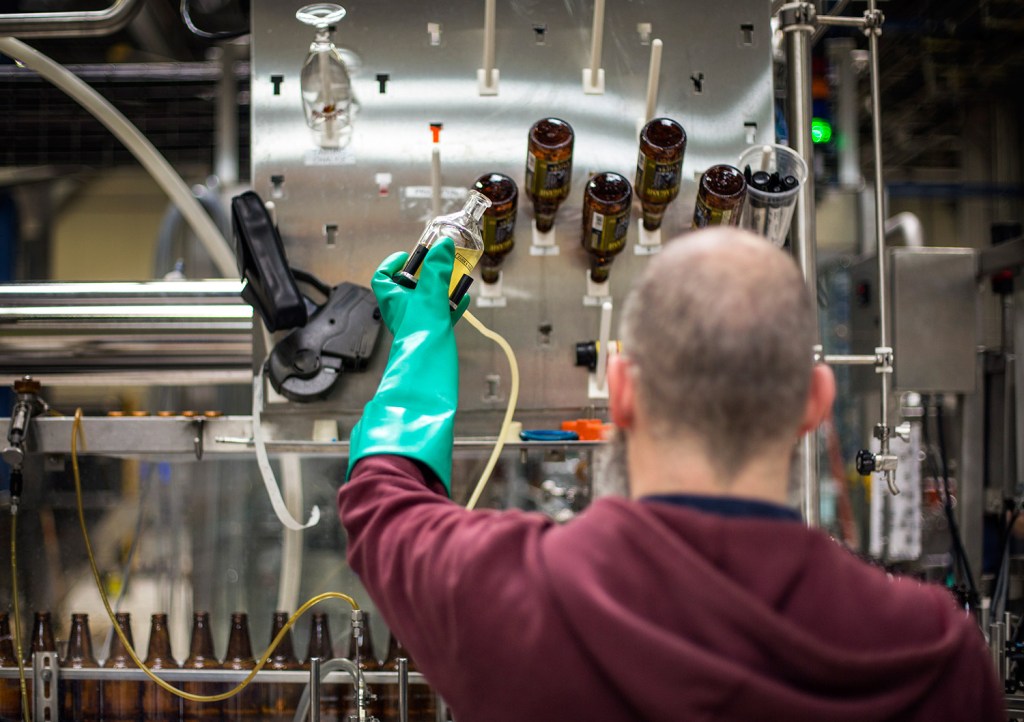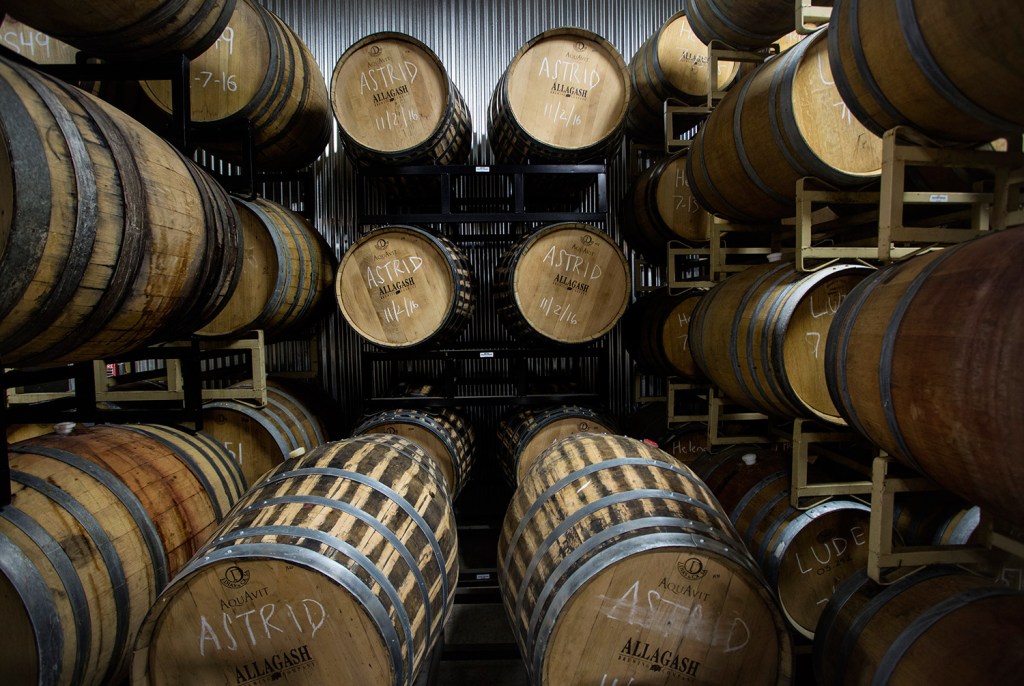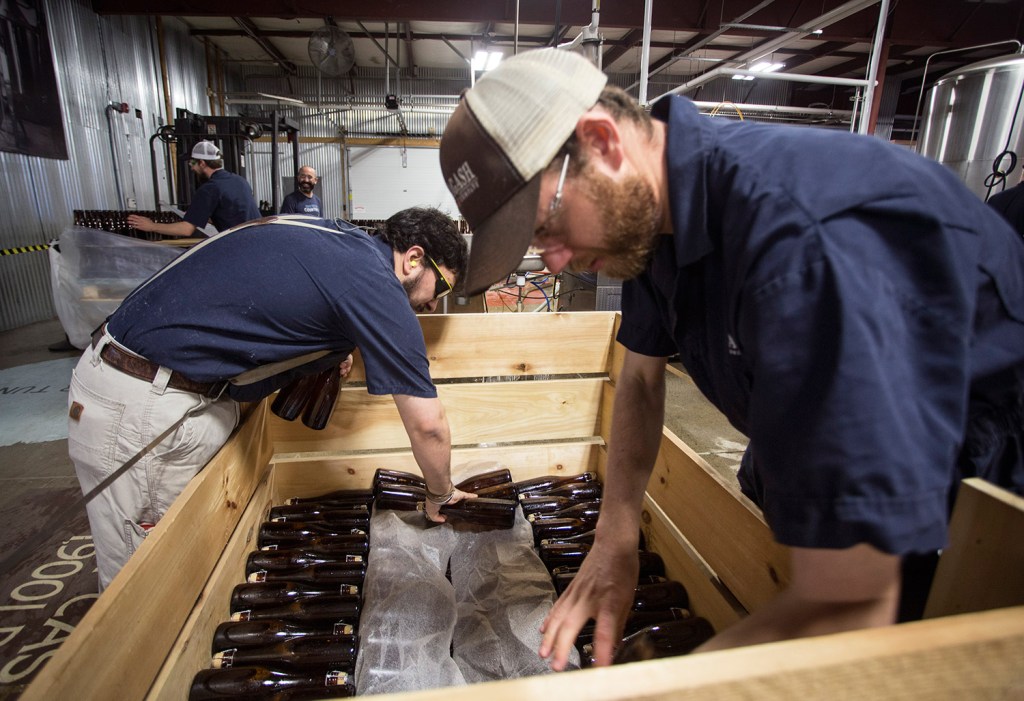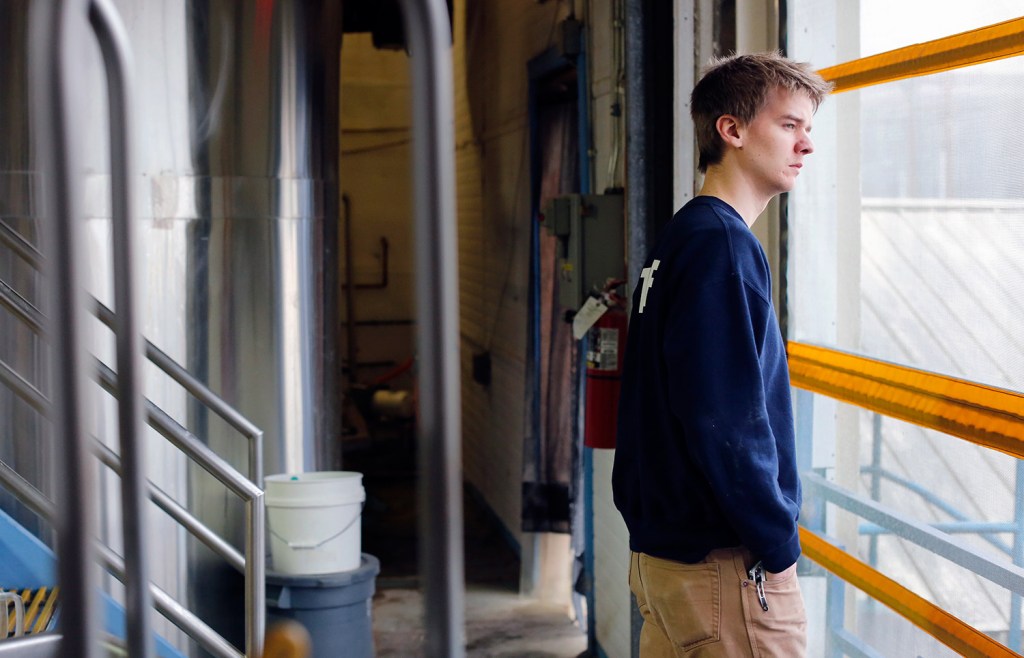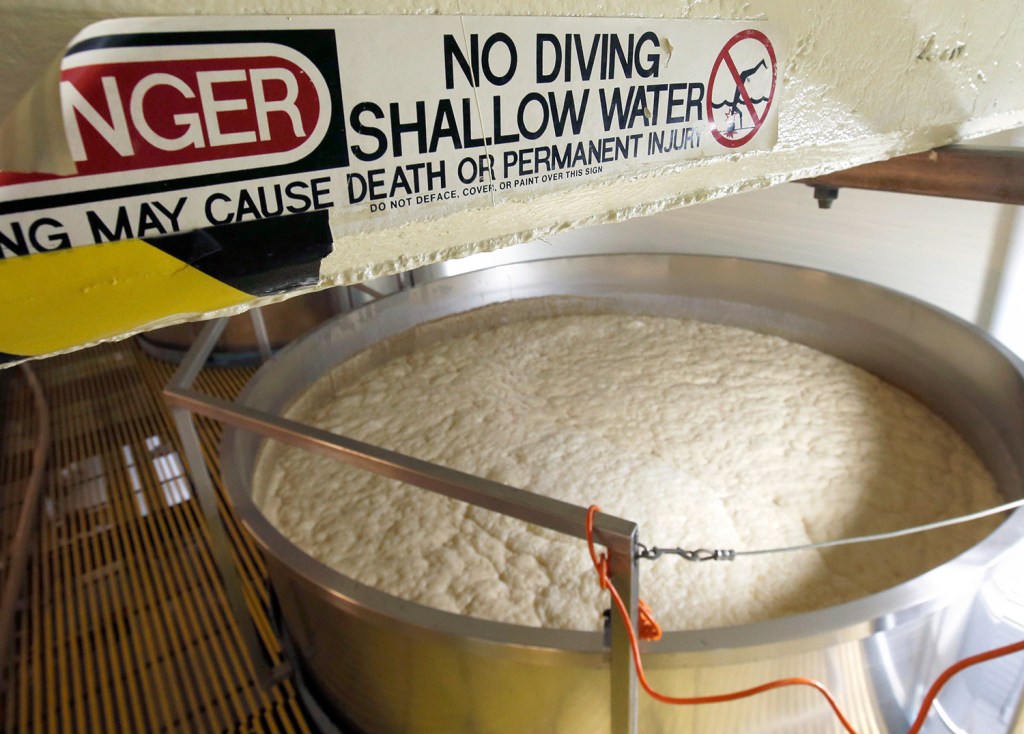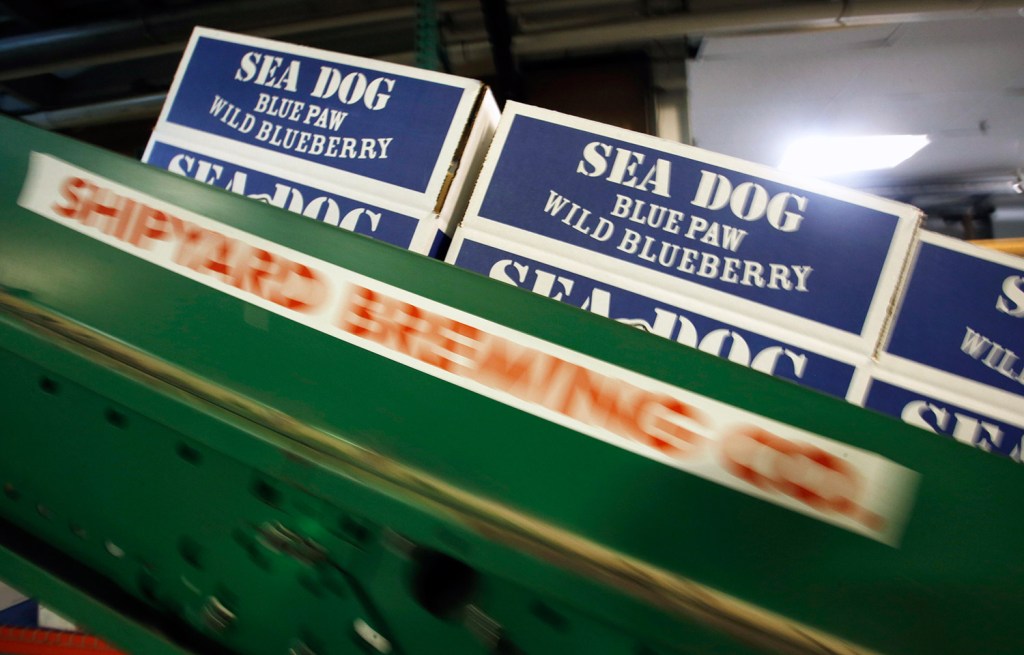A large walk-in cooler sits in the middle of Allagash’s Portland brewery. Pop open the door and the smell of bourbon wafts out. Inside are dozens of wood barrels that were once used to make bourbon. Now they hold thousands of gallons of Curieux, Allagash’s barrel-aged ale.
It’s a sight (and a smell) you won’t find on this scale anywhere else in the state. For years, Allagash has been the quirky brewery on the outskirts of the city. Now it’s poised to be the largest brewery in the state in 2017 – and still plenty quirky.
According to data provided by the state, Allagash made 2,865,584 gallons of beer in 2016. Though that’s well behind Shipyard’s 3,658,571 gallons, the two companies are trending in different directions. Shipyard has three straight years of declining production while Allagash hasn’t reported a reduction in the last 11 years.
Allagash has a nationwide reputation for producing high-quality Belgian-style beers, and that’s paying off with more production at its lone plant in Portland. Allagash added four new fermenters this winter – each with the capacity to make about 16,740 gallons of beer per batch. But brewmaster Jason Perkins, who has been with the company almost since it started, says being No. 1 isn’t part of Allagash’s master plan.
“We like the idea of growth because growth allows us to do things like give better benefits for our employees, better quality programs at the brewery, it allows us to innovate with our beer,” Perkins said. “So we like growth. Growth is good, but we’re not a competitive bunch that’s chasing a volume.”
If they wanted volume, Perkins said, they would sell beer in larger formats. The biggest quantity of beer Allagash sells in stores is a four-pack, a far cry from the 24-packs and 12-packs put out by national brewers.
Many of Allagash’s beers fetch a premium price. A four-pack of White – which consists of four 12-ounce bottles of the company’s flagship beer – costs about $10. A 24-pack of Hoppy Table Beer costs $57, plus tax and deposits, and is only sold at Allagash’s brewery. And the company makes a number of special releases that retail for up to $25 a bottle. On a per-ounce basis, Allagash’s cheapest offerings are at least 50 percent more expensive than any Shipyard offering.
Also unlike other brewers, Allagash doesn’t make any of the lagers, pilsners or American-style ales that have long dominated the market. Everything Allagash makes is Belgian-style, often with yeast-forward tastes and a cloudy appearance.
To be sure, Perkins says, Allagash is riding a cultural shift. When the brewery opened, most Americans didn’t know what a Belgian-style ale was, much less had they ever tried one. That brought up some questions for the brewers.
“It sure has changed,” Perkins said with a laugh. “When (Rob Tod) opened the brewery in 1995 and really for the first 10 years, it was tough to sell the beers we were making. People didn’t get them. They didn’t understand. They would look at Allagash White and say, ‘Why is this beer cloudy? It’s got spices in it? What’s up with that?’ ”
As beer drinkers become comfortable with branching out from lagers and ales, Allagash has grown steadily. Leading the growth is White, which contains a bit of coriander, and accounts for about 70 percent of all Allagash’s volume.
The growth continued in 2016 as Allagash produced 10.7 percent more beer than in 2015. The national Brewers Association ranked Allagash as the 35th-largest craft brewery in the country in 2016, up seven spots from 2015.
Chart: production volumes at Maine breweries
Chart: Christian MilNeil
Even rival brewers say they’re impressed by what Allagash has managed.
“If you want a model for doing it right and with integrity and focus, it’s Allagash,” said Andy Geaghan of Geaghan Bros. Brewing. “They’re going to be in the lead of anything they’re a part of.”
“What Allagash has done very well is focus on one or two key brands and built it out nationally,” said Shipyard co-founder Fred Forsley. “I’m hoping we can hit one of those.”
“They’re willing to spend on quality,” Sebago co-founder Kai Adams said. “You know Allagash is going to have quality.”
Quality invariably comes up in connection with Allagash.
The brewery’s commitment is obvious on the production line, where a batch of Tripel was being bottled on a weekday afternoon. A brewer stood at a station adjacent to the bottling line and checked carbonization of the beer. The brewery keeps sample bottles for three years from every batch of beer it sends out, so if a problem develops they can see what went wrong.
The quality testing room is just off the bottling line and looks more like a college chemistry lab than a brewery. In a room amid beakers and centrifuges, quality manager Zach Bodah says Allagash wants to know if something goes wrong so it can correct the problem.
“As years go by, you might get burned. You might have a bad batch of beer,” Bodah said. “If you don’t have a lot of tests around it, you don’t have a story to tell about the beer, you don’t know why it happened.”
FLAGGING PRODUCTION
While Allagash has consistently grown, several longtime brewers have seen their production drop dramatically in the past decade. Geary’s is down 59.3 percent from its best year in 2008, and the brewery was sold to an investor as it apparently faced bankruptcy late in 2016. Gritty’s is down 43 percent from its all-time high in 2008.
And Shipyard, which has led the state in production for at least the past 11 years, is down 29 percent from its 2013 peak. Although Shipyard disputes the state’s data, saying it includes beer Shipyard brewed under contract for other breweries, data provided by Shipyard also show a 29 percent decline.
Forsley, who co-founded Shipyard in 1994, says a number of factors have hampered his brewery, complicated by the fact that a little of Shipyard’s production has shifted to its facility in Florida. As craft breweries have proliferated across the country, Shipyard faces tougher markets in outlying states like North Carolina and California, Forsley said. The problem isn’t necessarily winning over consumers, it’s winning over distributors who fight for shelf space and put beers on draft in bars. And since Shipyard distributes to 42 states and there are over 5,000 craft breweries in the U.S., there’s plenty of competition.
“We haven’t necessarily gone backward in our core markets like Maine, New Hampshire and Massachusetts,” Forsley said. “But the non-core markets, it’s been more difficult not so much because of consumer demand, but by getting our distributors to represent us. They can only dance with so many partners, you know.”
Another major factor hindering Shipyard has been a slump in seasonal pumpkin-flavored beers across the country. Pumpkinhead is Shipyard’s top seller, accounting for about 40 percent of production even though it is only available three months a year.
But demand for pumpkin beers dropped sharply over the past two years – and the style even earned ridicule from Budweiser in an infamous Super Bowl ad that slammed craft beer. Forsley thinks pumpkin beers will rebound, and when they do, Pumpkinhead will be near the front of the pack.
“Pumpkinhead is the huge beer for us; it’s been the thing that’s grown our volume on a national level,” he said. “The good news, from our standpoint, is it’s still one of the leaders in the pumpkin category. But the last two years the issue has been an overflow of pumpkin beers.”
Forsley says he’s been through slumps like this before in his 25 years in the industry and expressed confidence Shipyard would regain its footing.
The waning production from stalwarts like Shipyard, Gritty’s and Geary’s led to a statewide drop in beer production in Maine in 2016. The state produced 2 percent less beer in 2016 than the year before, the first drop since a 3 percent dip in 2008.
Bart Watson, chief economist at the national Brewers Association, says that makes sense. The beer economy exploded for a number of years as consumers lapped up new local brews and national brewers like Budweiser and Miller lost market share. That’s not going to happen again, Watson said.
“It’s going to look more like the restaurant scene, which is a one-in, one-out situation,” Watson said. “By that I mean when one brewery closes, another one will open. But we’re not going to see another 5,000 breweries opening.”
Maine now has at least 93 active breweries, with at least a couple more planned in the Portland area.
COMPETITIVE LANDSCAPE
Shipyard is not alone in its decline. Boston Beer Co. – which makes Samuel Adams – has seen its beer sales fall. As a publicly traded company, Boston Beer publishes its financials, which offer a window into the struggles faced by large craft breweries.
The numbers in Boston Beer’s first-quarter results this year are daunting. Boston Lager sales dropped 8 percent. Rebel IPA is down 20 percent.
With its beer production sinking, Boston Beer has been inventing new alcoholic beverages, with some hits in the lineup, to try to remain afloat. The company makes hard seltzers. Angry Orchard ciders are made by Boston Beer. And Twisted Tea – an alcohol-infused tea – has been a hit for Boston Beer.
As a result, malt beverages and ciders now account for 42.8 percent of all Boston Beer’s production. If that number goes over 50 percent, Samuel Adams will no longer be considered craft beer by the Brewers Association.
Peter Frost, who covers the beer industry for Crain’s in Chicago, says Shipyard is not unlike Sam Adams, though on a much smaller scale.
“Regional brewers the size of Shipyard are the ones most at risk in this part of the market cycle,” Frost said. “They’re not new and exciting like the startup craft brewers eating their lunch and taking away their tap handles.”
Andy Crouch, who has a beer column in Beer Advocate, says Shipyard’s problems extend beyond a business level. As beer fans’ tastes have evolved, Shipyard’s traditional English-style ales have fallen from favor with consumers.
“Shipyard’s in a tough spot and it has been for quite some time,” Crouch said. “It’s been out of favor with beer geeks for quite some time. It has a very old New England flavor profile, with ringwood yeast, that old English style which used to define New England craft beer 15 years ago. Increasingly it doesn’t have much of a place.”
Both Crouch and Frost say Allagash stands in sharp contrast to Shipyard. Much of Allagash’s growth is tied to White, which has won over tap handles in bars from local watering holes to fickle, high-end beer bars. And, Frost says, White appeals to a constituency often overlooked by beer makers: women.
“Allagash has a few things going for it that we shouldn’t dismiss, such as its flagship, which appeals not only to the hard-core beer nerd who knows a near-perfect beer when she sips one, but also to the occasional beer drinker who typically drinks wine or adjunct American lagers. It’s sort of a gateway beer,” Frost said.
Will Ikard of Newcastle got his first taste of Allagash when he lived in Texas (before the company stopped distribution there). His favorite beers in his early 20s were light Mexican beers like Tecate and Pacifico. White was one of the “slightly more exotic” wheat beers he could regularly find.
Now 35 and a father, Ikard has never visited the Portland brewery. He simply picks up a four-pack of Hoppy Table Beer or White at a local store. He’s developed a taste for it, he says, and since he’s only having a few beers, he wants to savor them.
“I generally like to support local businesses across the board and I’m willing to pay a premium for that,” Ikard said. “I’m comparing Allagash to foreign beers or really micro, artisanal stuff, and in that market, it’s not particularly expensive.”
Matt Taylor of Biddeford can relate to that. The 32-year-old spent his college years drinking the cheapest beers he could find.
“Things that will get you buzzed,” he said.
Taylor discovered Allagash White on a trip to Bull Feeney’s – the longtime Portland pub – and says he still picks up Allagash beers.
“It’s good to sit back, hanging out by the lake and have a few beers,” Taylor said. “I guess at my age it’s not about getting drunk, it’s about the experience. Taking in a good beer with the people who mean the most to you.”
Once beer drinkers like Taylor and Ikard develop a taste for Belgian ales, Allagash has plenty of offerings in its catalog to keep people engaged as they seek more complexity in their beer, Crouch said. Both Ikard and Taylor cited more obscure bottle offerings from Allagash as among their favorites.
“They’ve been innovative since the day they opened,” Crouch said. “They have always pushed the envelope there, which has kept the beer geek market engaged, so they have been able to attract with White pretty much any drinker on the planet, and then keep the beer nerds also engaged.”
WILD FERMENTATION
Outside and around the back of Allagash’s brewery sits a little room with stained-glass windows. It’s meant to look like an old Belgian brewery.
When the weather is chilly enough – it needs to be cold, but not so cold that the beer freezes – hot, unfermented beer is pumped onto a metal tray in the room. Then it just sits there on the tray, known as a coolship, exposed to the elements and picking up wild yeast strains for 12 hours. Then brewers pump the beer back into the brewery and stuff it into French oak wine barrels, where it sits for one to three years. Often, they age the beer on fruit like cherries or raspberries. The beers are released under Allagash’s “Coolship” label and cost $15 for a 12.7-ounce bottle.
And they can’t make enough of it. About a decade ago, as demand surged for its products, Allagash pulled out of Florida, Texas, Washington, Ohio, Michigan, Colorado, Indiana and Oregon. Allagash wasn’t able to keep up with demand and it was too hectic for the company, Perkins said.
The company now serves 17 states, with no plans to expand.
“We recognize it’s a different time than it was five years ago. We had times where we were growing 40 percent in a year. I don’t think we’d want to go back to that even if we could,” Perkins said. “So yes, we plan to grow, but it’s careful and growth on our own terms.”
James Patrick can be contacted at 791-6382 or at:
jpatrick@pressherald.com
Twitter: @mesofunblog
Send questions/comments to the editors.

